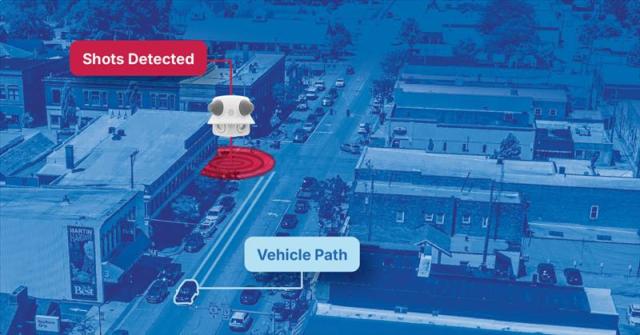When Shots Are Fired: How SDS Gunshot Detection Helped Capture a Shooter
Gun violence can devastate communities, especially in cities where shootings occur frequently. For one city grappling with crime, Shooter Detection Systems (SDS) Perimeter Outdoor Gunshot Detection sensors proved to be a game-changer. Built with military-grade technology, SDS sensors detect gunfire and send alerts in less than three seconds, providing law enforcement with real-time intelligence that can save lives and lead to faster apprehensions.
This was the case one evening when SDS sensors helped police quickly respond to a drive-by shooting, ultimately leading to the arrest of the shooter. Here’s how the technology worked and how it continues to empower law enforcement in their fight against gun violence.
The Incident: Shots Fired Downtown
It was just before midnight when gunfire erupted near a retail store in a crime-ridden downtown area. A shooter fired multiple rounds from a moving vehicle, targeting the storefront. There were no victims, witnesses, or damage, so how do we know this incident happened? Thanks to SDS’s outdoor gunshot detection sensors, the shots were instantly detected, and the police were alerted in real time.
For a city in a state where gun-related homicides are almost 25% higher than the national average, this rapid detection was critical. The SDS sensors provided actionable intelligence, giving police the information needed to act decisively.
How SDS Sensors Made the Difference
The city deployed three SDS Perimeter Outdoor Gunshot Detection Sensors at intersections where gun violence is prevalent. These sensors, with a detection range of up to 150 feet and a 180-degree field of view, use a dual-verification system to confirm gunfire through both acoustic and infrared signals. Shot processing is automatic, ensuring speed and accuracy without the need for human verification of gunshots, a feature that protects data and citizen privacy.
Here’s how the sensors worked during the incident:
- Dual-factor Detection: At the intersection where the shooting occurred, one sensor captured both acoustic and infrared signals, conclusively verifying gunfire with SDS’s 99.9% accuracy rate.
- Location Mapping: The sensors pinpointed the intersection where the shots were fired and provided police with a map.
- Vehicle Data: Using additional data from the sensor, SDS was able to calculate the speed of the shooter and identify that they were in a moving vehicle traveling at 37 miles per hour. As the shooter continued firing, the sensor data also helped calculate the pattern of gunfire, showing four rapid-fire shots at the building.
- Weapon Identification: Using advanced algorithms, SDS determined the firearm type—a handgun.
This automated flow of information eliminated reliance on slower human interventions, such as witness reports or shell casing discoveries, enabling police to act faster.
The Role of SDS Integrations
The intelligence provided by the SDS sensors was further enhanced by their integration with the police department’s video management system. Using the timeframe and location data from the sensors, police accessed surveillance footage of the scene.
The video revealed a vehicle traveling down the road with a firearm visible from the driver’s side window. Officers identified the make and model of the car and captured the full license plate details.
This seamless integration between SDS sensors and video systems gave police the evidence needed to track the suspect and move quickly to apprehend him.
The Outcome
Armed with sensor data and video footage, police located the suspect and arrested him. A search of the vehicle uncovered additional evidence, including multiple shell casings that matched the gunfire detected by SDS.
This swift resolution not only removed a dangerous criminal from the streets but also demonstrated the value of SDS technology in detecting a gun violence incident, expediting investigations, and improving public safety.
Next Steps for the Police Department
Impressed by the effectiveness of SDS sensors, the police department has deployed an additional 12 sensors in high-risk areas throughout the city. Beyond detecting gunfire and aiding investigations, the sensors will provide long-term data to evaluate crime trends and improve resource allocation.
Conclusion
When shots are fired, SDS Perimeter Outdoor Gunshot Detection Sensors deliver real-time intelligence that empowers law enforcement to act quickly and decisively. In this case, the technology ensured a dangerous criminal was apprehended before he could escape or cause further harm.
SDS continues to be the recognized leader in outdoor gunshot detection, trusted by law enforcement and SAFETY Act Certified by the U.S. Department of Homeland Security.
To learn more about how gunshot detection can secure your outdoor spaces and download the case study, click on the button below and add “send me the case study” to the form comments.

